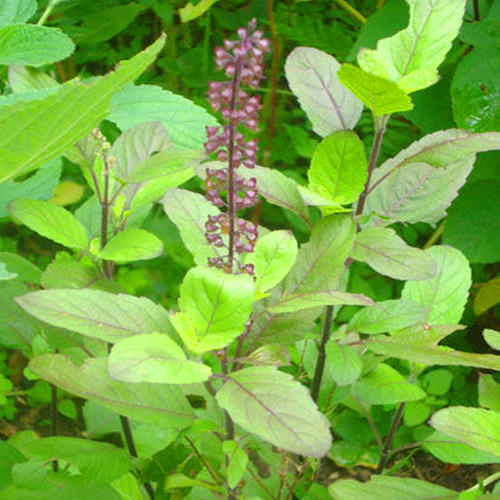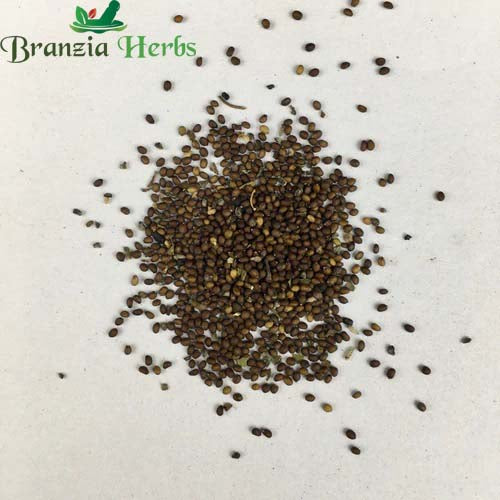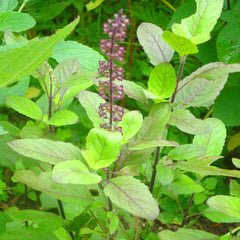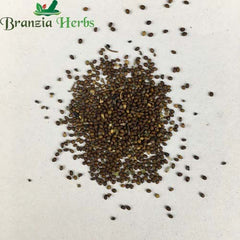Tulsi Rama, also known as Rama Tulsi or Sweet Basil (Ocimum tenuiflorum), is a cherished herb in Hindu tradition and Ayurvedic medicine. It is renowned for its health benefits, aromatic leaves, and spiritual significance. Here’s a detailed guide on Tulsi Rama Plant Seeds, including their characteristics, benefits, and planting care:
Characteristics
-
Appearance:
- Seeds: Tulsi Rama seeds are small, dark brown to black, and round. They are typically about 1-2 mm in diameter.
- Plant: The Rama Tulsi plant is a bushy herb with green leaves that are less pungent compared to Krishna Tulsi. It can grow up to 30-60 cm (12-24 inches) tall and produces small, light purple or white flowers.
-
Leaves:
- Color: The leaves are green and have a mild, sweet aroma.
- Shape: The leaves are oval with a smooth edge and a slightly fuzzy texture.
Benefits
-
Medicinal Uses:
- Anti-inflammatory and Antioxidant: Rama Tulsi contains compounds with anti-inflammatory and antioxidant properties, beneficial for overall health.
- Immune System Support: It helps boost the immune system and is used to alleviate respiratory and digestive issues.
- Stress Relief: Known for its adaptogenic properties, Tulsi Rama can help reduce stress and anxiety.
-
Culinary Uses:
- Flavoring: The leaves are used in cooking for their mild, sweet flavor, and are often used in teas and various culinary dishes.
- Herbal Teas: Tulsi Rama leaves are commonly used to make soothing herbal teas with health benefits.
-
Spiritual and Cultural Significance:
- Religious: In Hinduism, Tulsi Rama is considered sacred and is often grown in homes and temples for worship and spiritual practices.
-
Cosmetic Uses:
- Skincare: Due to its antibacterial properties, Tulsi Rama is used in skincare products and home remedies for its potential to treat acne and other skin issues.
Planting Tulsi Rama Seeds
-
Preparation:
- Seed Treatment: Tulsi Rama seeds do not require special treatment before planting. However, soaking seeds in water for a few hours can aid in germination.
-
Timing:
- Optimal Season: Plant Tulsi Rama seeds in the spring or early summer when temperatures are warm and conditions are favorable for growth.
-
Soil and Location:
- Soil Type: Prefers well-drained, loamy or sandy soil enriched with organic matter. Ensure good drainage to prevent waterlogging.
- Location: Choose a sunny location with full sun exposure. Tulsi Rama thrives in warm climates but can also be grown indoors in cooler areas.
-
Planting:
- Sowing Seeds: Sow seeds about 1/4 inch (0.5 cm) deep in the soil. Space the seeds or seedlings about 6-12 inches (15-30 cm) apart to allow for growth.
- Germination: Seeds typically germinate within 7-14 days. Keep the soil consistently moist but not waterlogged during this period.
-
Watering:
- Initial Care: Water the soil thoroughly after planting and keep it consistently moist until seedlings are established. Avoid overwatering.
- Ongoing Care: Maintain regular watering, especially during dry periods. Tulsi Rama prefers moist soil but can tolerate short dry spells.
-
Fertilizing:
- Nutrients: Fertilize with a balanced fertilizer or compost during the growing season to support healthy growth. Tulsi Rama benefits from organic matter.
Care and Maintenance
-
Pruning:
- Trimming: Regularly pinch back the tips of the plant to encourage bushier growth and prevent it from becoming leggy. Remove any dead or yellowing leaves.
-
Pest and Disease Management:
- Monitoring: Tulsi Rama is generally resistant to pests and diseases but should be monitored for issues such as aphids, fungal infections, or leaf spots.
- Control: Use appropriate treatments if problems arise, following local guidelines.
-
Harvesting:
- Timing: Harvest leaves once the plant is well-established and has plenty of foliage. Regular harvesting can encourage new growth.
- Method: Pick leaves and stems as needed for use. You can also harvest and dry leaves for later use in teas and herbal remedies.
-
Protection:
- Young Plants: Protect young plants from extreme weather conditions and pests until they are well-established.
Environmental Considerations
- Climate Adaptation: Tulsi Rama prefers warm, sunny climates but can be grown indoors in cooler areas with sufficient light.
- Sustainability: Ensure that planting practices are sustainable and adhere to local regulations regarding agriculture and conservation.
Summary
Tulsi Rama (Rama Tulsi or Sweet Basil) seeds offer numerous benefits, including medicinal, culinary, and spiritual uses. By following proper planting and care guidelines, you can successfully grow Tulsi Rama and enjoy its many advantages. Tulsi Rama thrives in warm, sunny conditions and requires consistent moisture and well-drained soil for optimal growth.






